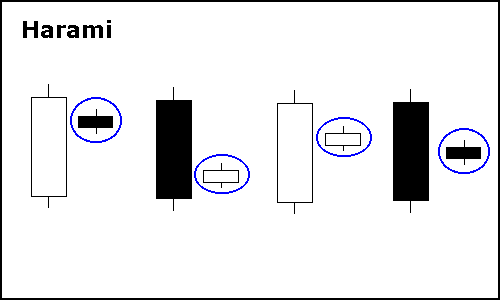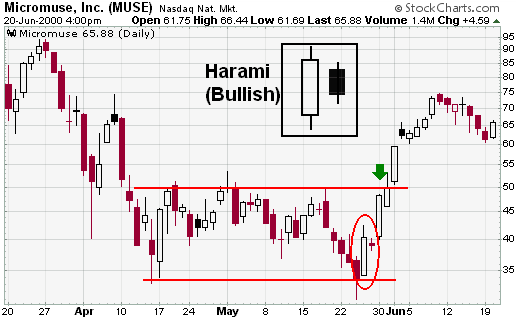Bullish Harami Candlestick Pattern

A related pattern is the three inside up pattern that is found at bottoms. The three inside up pattern is a confirmed bullish harami pattern where the first day is a bearish candlestick followed by a small body bullish candlestick where its price range is within the first day’s real body. The third candlestick is a bullish candle that opens within or above the real body of the second day and then closes above the high of the first day’s bearish candlestick. A less demanding form of the pattern requires that the third day close above the close of the second day’s candlestick.
Bullish Harami Cross Candlestick Pattern

Psychology of Bullish Harami

Traits that Increase a Bullish Harami's Effectiveness
Nison (1994, p. 87) gives important traits that increase a bullish harami’s importance:- The more the real body of the second day is at the midpoint of the first day’s real body, the better the reversal of the trend. However, following a downtrend when the second day’s small real body candlestick is toward the bottom area of the first day’s candlestick real body, the greater the chance of consolidation rather than a reversal upward.
- The more the open, high, low, and close are within the prior day’s real body, the greater the chance of reversal.
- The smaller the shadows and real body of the second day and thus the more like a doji the second day is, the higher the probability of a full reversal.
Blended Candle Analysis of Bullish Harami = Hammer

Harami Pattern Downtrend Consolidation and Support Example

Harami Cross Bottom Example

Bullish Harami
The bullish harami is made up of two candlesticks. The first has a large
body, while the second has a small body that is totally encompassed by
the first. There are four possible combinations: white/white, white/black, black/white and black/black.
Whether they are bullish reversal or bearish reversal patterns, all
harami look the same. Their bullish or bearish nature depends on the
preceding trend. Harami are considered potential bullish reversals after
a decline and potential bearish reversals after an advance. No matter
what the color of the first candlestick, the smaller the body of the
second candlestick is, the more likely the reversal. If the small
candlestick is a doji, the chances of a reversal increase.

In his book Beyond Candlesticks, Steve Nison asserts that any combination of colors can form a harami, but that the most bullish are those that form with a white/black or white/white combination. Because the first candlestick has a large body, it implies that the bullish reversal pattern would be stronger if this body were white. The long white candlestick shows a sudden and sustained resurgence of buying pressure. The small candlestick afterwards indicates consolidation. White/white and white/black bullish harami are likely to occur less often than black/black or black/white.
After a decline, a black/black or black/white combination can still be regarded as a bullish harami. The first long black candlestick signals that significant selling pressure remains, which could indicate capitulation. The small candlestick immediately following forms with a gap up on the open, indicating a sudden increase in buying pressure and potential reversal.

Micromuse (MUSE) declined to the mid-sixties in Apr-00 and began to trade in a range bound by 33 and 50 over the next few weeks. After a 6-day decline back to support in late May, a bullish harami (red oval) formed. The first day formed a long white candlestick, while the second formed a small black candlestick that could be classified as a doji. The next day's advance provided bullish confirmation and the stock subsequently rose to around 75.
Source :- https://school.stockcharts.com/doku.php?id=chart_analysis:candlestick_bullish_reversal_patterns

In his book Beyond Candlesticks, Steve Nison asserts that any combination of colors can form a harami, but that the most bullish are those that form with a white/black or white/white combination. Because the first candlestick has a large body, it implies that the bullish reversal pattern would be stronger if this body were white. The long white candlestick shows a sudden and sustained resurgence of buying pressure. The small candlestick afterwards indicates consolidation. White/white and white/black bullish harami are likely to occur less often than black/black or black/white.
After a decline, a black/black or black/white combination can still be regarded as a bullish harami. The first long black candlestick signals that significant selling pressure remains, which could indicate capitulation. The small candlestick immediately following forms with a gap up on the open, indicating a sudden increase in buying pressure and potential reversal.

Micromuse (MUSE) declined to the mid-sixties in Apr-00 and began to trade in a range bound by 33 and 50 over the next few weeks. After a 6-day decline back to support in late May, a bullish harami (red oval) formed. The first day formed a long white candlestick, while the second formed a small black candlestick that could be classified as a doji. The next day's advance provided bullish confirmation and the stock subsequently rose to around 75.
Source :- https://school.stockcharts.com/doku.php?id=chart_analysis:candlestick_bullish_reversal_patterns
No comments:
Post a Comment